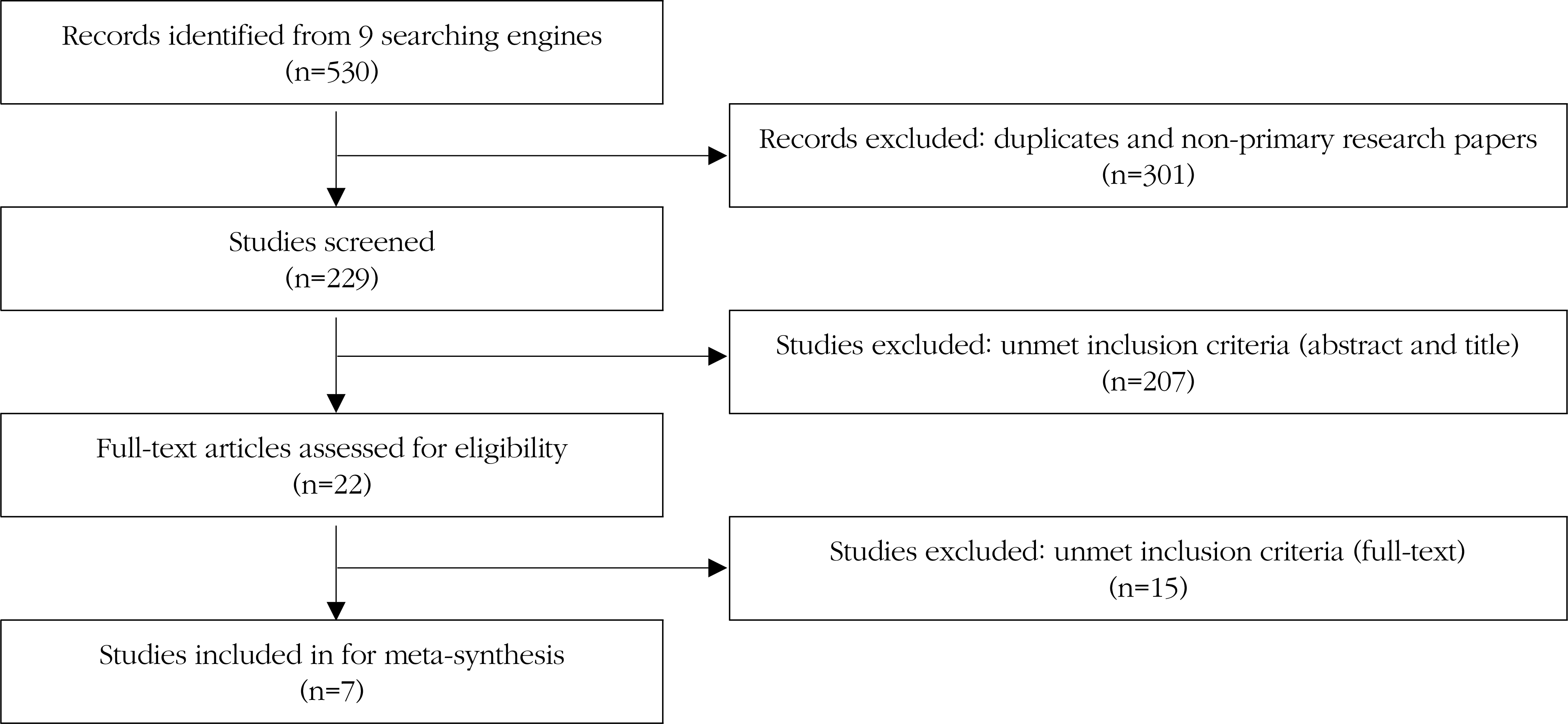Abstract
Purpose
Lung cancer patients are often stigmatized since lung cancer is closely associated with smoking, which is a self-administered life style. The stigma of lung cancer has been examined in some qualitative studies; however, their findings were diverse and not yet synthesized. Therefore, this meta-synthesis study aimed to explore how lung cancer patients experience stigma.
Methods
A meta-synthesis method, as suggested by Sandelowski and Barroso in 2007, was applied by aggregating the findings after an evaluation according to consolidated criteria for reporting qualitative research (COREQ).
Results
By synthesizing the findings of the selected seven papers, a synthesized theme was emerged as “experiencing external and internal distances, which mandates authentic and consistent supports.” The four sub-themes included ‘experiencing some distance from the surrounded world,’ ‘experiencing self-made distance between the disease and oneself,’ ‘the disease experience causes social isolation and loneliness,’ and ‘there is lack of supportive care for myself.’
REFERENCES
1.Korea Central Cancer Registry. National cancer statistics in 2014. Goyang-si, Gyeonggi-do: National Cancer Information Center;2014. [cited 2015 September 25]. Available from:. http://www.cancer.go.kr/mbs/cancer/subview.jsp?id=cancer_040201000000.
2.Chatwin J., Sanders C. The influence of social factors on help-seeking for people with lung cancer. European Journal of Cancer Care. 2013. 22(6):709–13. http://dx.doi.org/10.1111/ecc.12078.

3.Schag C., Ganz P., Wing D., Sim MS., Lee J. Quality of life in adult survivors of lung, colon and prostate cancer. Quality of Life Research. 1994. 3(2):127–41.

4.Sikorskii A., Given CW., Given B., Jeon S., Decker V., Decker D, et al. Symptom management for cancer patients: a trial comparing two multimodal interventions. Journal of Pain and Symptom Management. 2007. 34(3):253–64. http://dx.doi.org/10.1016/j.jpainsymman.2006.11.018.
5.Sarna L., Evangelista L., Tashkin D., Padilla G., Holmes C., Brecht ML, et al. Impact of respiratory symptoms and pulmonary function on quality of life of long-term survivors of non-small cell lung cancer. Chest. 2004. 125(2):439–45. http://dx.doi.org/10.1378/chest.125.2.439.

6.Zabora J., BrintzenhofeSzoc K., Curbow B., Hooker C., Pian-tadosi S. The prevalence of psychological distress by cancer site. Psycho-Oncology. 2001. 10(1):19–28.

7.Hill KM., Amir Z., Muers MF., Connolly CK., Round CE. Do newly diagnosed lung cancer patients feel their concerns are being met? European Journal of Cancer Care. 2003. 12(1):35–45. http://dx.doi.org/10.1046/j.1365-2354.2003.00324.x.

8.American Cancer Society. Cancer Facts & Figures 2012. Atlanta GA: American Cancer Society;2012. [cited 2015 December 18]. Available from:. http://www.cancer.org/acs/groups/content/@epidemiologysurveilance/documents/document/acspc-031941.pdf.
9.Goffman E. Stigma: notes on the management of spoiled identity. Cliffs E, editor. editor.New Jersey: Prentice Hall;1963.
10.LoConte NK., Else-Quest NM., Eickhoff J., Hyde J., Schiller JH. Assessment of guilt and shame in patients with non-small-cell lung cancer compared with patients with breast and prostate cancer. Clinical lung cancer. 2008. 9(3):171–8. http://dx.doi.org/10.3816/CLC.2008.n.026.

11.Gonzalez BD., Jacobsen PB. Depression in lung cancer patients: the role of perceived stigma. Psycho-Oncology. 2012. 21(3):239–46. http://dx.doi.org/10.1002/pon.1882.

12.Conlon A., Gilbert D., Jones B., Aldredge P. Stacked stigma: oncology social workers' perceptions of the lung cancer experience. Journal of Psychosocial Oncology. 2010. 28(1):98–115. http://dx.doi.org/10.1080/07347330903438982.

13.Lee JL., Kim KS. The Relationships between stigma, distress, and quality of life in patients with lung cancer. Asian Oncology Nursing. 2011. 11(3):237–46. http://dx.doi.org/10.5388/jkon.2011.11.3.237.

14.Byun HS., Kim EK., Kim GD. Impacts of stigma and distress on the quality of Life in patients with lung cancer. Journal of safety and crisis management. 2015. 11(8):223–40.
15.Cho J., Smith K., Choi EK., Kim IR., Chang YJ., Park HY, et al. Public attitudes toward cancer and cancer patients: a national survey in Korea. Psycho-Oncology. 2013. 22(3):605–13. http://dx.doi.org/10.1002/pon.3041.

16.Kim MA., Yi J. Life after cancer: How does public stigma increase psychological distress of childhood cancer survivors? International journal of nursing studies. 2014. 51(12):1605–14. http://dx.doi.org/10.1016/j.ijnurstu.2014.04.005.

17.Bowling A. Research methods in health: investigating health and health services. McGraw-Hill Education (UK);2014.
18.Jensen LA., Allen MN. Meta-synthesis of qualitative findings. Qualitative Health Research. 1996. 6(4):553–60.

19.Sandelowski M., Barroso J. Handbook for synthesizing qualitative research. Springer Publishing Company;2007.
20.Finfgeld DL. Metasynthesis: the state of the art-so far. Qualitative Health Research. 2003. 13(7):893–904. http://dx.doi.org/10.1177/1049732303253462.

21.Sandelowski M., Voils CI., Barroso J. Comparability work and the management of difference in research synthesis studies. Social Science & Medicine. 2007. 64(1):236–47. http://dx.doi.org/10.1016/j.socscimed.2006.08.041.

22.Tong A., Sainsbury P., Craig J. Consolidated criteria for reporting qualitative research (COREQ): a 32-item checklist for interviews and focus groups. International Journal for Quality in Health Care. 2007. 19(6):349–57.

23.Joanna Briggs Institute. Joanna Briggs Institute reviewers' manual 2014: methodology for JBI umbrella reviews. Australia: Joanna Briggs Institute;2014. [cited 2015 December 23]. Available from:. http://joannabriggs.org/assets/docs/sumari/ReviewersManual-Methodology-JBI_Umbrella%20Reviews-2014.pdf.
24.LeBel TP. Perceptions of and responses to stigma. Sociology Compass. 2008. 2(2):409–32. http://dx.doi.org/10.1111/j.1751-9020.2007.00081.x.

25.Corrigan PW., Watson AC. The paradox of self-stigma and mental illness. Clinical Psychology: Science and Practice. 2002. 9(1):35–53. http://dx.doi.org/10.1093/clipsy.9.1.35.

26.Corrigan PW. The impact of stigma on severe mental illness. Cognitive and Behavioral Practice. 1999. 5(2):201–22. http://dx.doi.org/10.1016/S1077-7229(98)80006-0.

27.British Columbia Ministry of Health. Social isolation of seniors: an emerging issues. Children's, Women's and Seniors Health Branch. Canada: Ministry of Health;2004. [cited 2015 December 22]. Available from:. http://www.health.gov.bc.ca/library/publications/year/2004/Social_Isolation_Among_Seniors.pdf.
28.Weiss J., Stephenson BJ., Edwards LJ., Rigney M., Copeland A. Public attitudes about lung cancer: stigma, support, and predictors of support. Journal of Multidisciplinary Healthcare. 2014. 7:293–300. http://dx.doi.org/10.2147/JMDH.S65153.

Table 1.
Searching Terms AND “Stigma” (MeSH)
| “Lung cancer” (MeSH) | ||
| OR | ||
| Lung cancer | ||
| OR | ||
| Pulmonary cancer | “Stigma”: (MeSH) | |
| OR | OR | |
| Lung tumo?r | AND | Stigma∗ |
| OR | ||
| Pulmonary tumo?r | ||
| OR | ||
| Lung carcinoma | ||
| OR | ||
| Pulmonary carcinoma |
Table 2.
Summary of the Included Studies
Table 3.
Quality Appraisal Tool (COREQ)
Table 4.
Meta-aggregation Process




 PDF
PDF ePub
ePub Citation
Citation Print
Print



 XML Download
XML Download